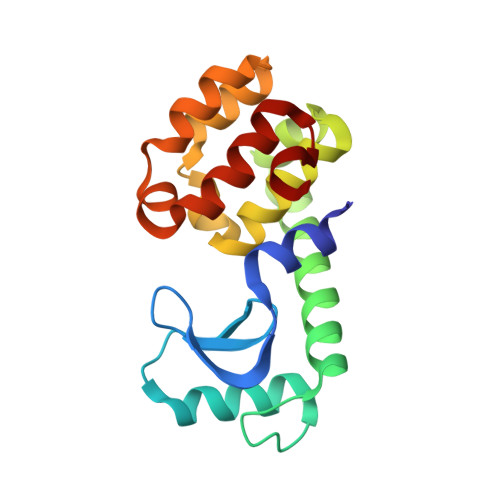Multiple methionine substitutions are tolerated in T4 lysozyme and have coupled effects on folding and stability
Gassner, N.C., Baase, W.A., Mooers, B.H., Busam, R.D., Weaver, L.H., Lindstrom, J.D., Quillin, M.L., Matthews, B.W.(2003) Biophys Chem 100: 325-340
- PubMed: 12646375
- DOI: https://doi.org/10.1016/s0301-4622(02)00290-9
- Primary Citation of Related Structures:
1KS3, 1KW5, 1KW7, 1KY0, 1KY1, 1L0J, 1L0K, 1LPY, 1LW9, 1LWG, 1LWK - PubMed Abstract:
In order to further explore the tolerance of proteins to amino acid substitutions within the interior, a series of core residues was replaced by methionine within the C-terminal domain of T4 lysozyme. By replacing leucine, isoleucine, valine and phenylalanine residues a total of 10 methionines could be introduced, which corresponds to a third of the residues that are buried in this domain. As more methionines are incorporated the protein gradually loses stability. This is attributed in part to a reduction in hydrophobic stabilization, in part to the increased entropic cost of localizing the long, flexible methionine sidechains, and in part to steric clashes. The changes in structure of the mutants relative to the wildtype protein are modest but tend to increase in an additive fashion as more methionines are included. In the most extreme case, namely the 10-methionine mutant, much of the C-terminal domain remains quite similar to wildtype (root-mean-square backbone shifts of 0.56 A), while the F and G helices undergo rotations of approximately 20 degrees and center-of-mass shifts of approximately 1.4 A. For up to six methionine substitutions the changes in stability are additive. Beyond this point, however, the multiple mutants are somewhat more stable than suggested from the sum of their constituents, especially for those including the replacement Val111-->Met. This is interpreted in terms of the larger structural changes associated with this substitution. The substituted sidechains in the mutant structures have somewhat higher crystallographic thermal factors than their counterparts in WT*. Nevertheless, the interiors of the mutant proteins retain a well-defined structure with little suggestion of molten-globule characteristics. Lysozymes in which selenomethionine has been incorporated rather than methionine tend to have increased stability. At the same time they also fold faster. This provides further evidence that, at the rate-limiting step in folding, the structure of the C-terminal domain of T4 lysozyme is similar to that of the fully folded protein.
Organizational Affiliation:
Institute of Molecular Biology, Howard Hughes Medical Institute, 1229 University of Oregon, Eugene, OR 97403-1229, USA.
















